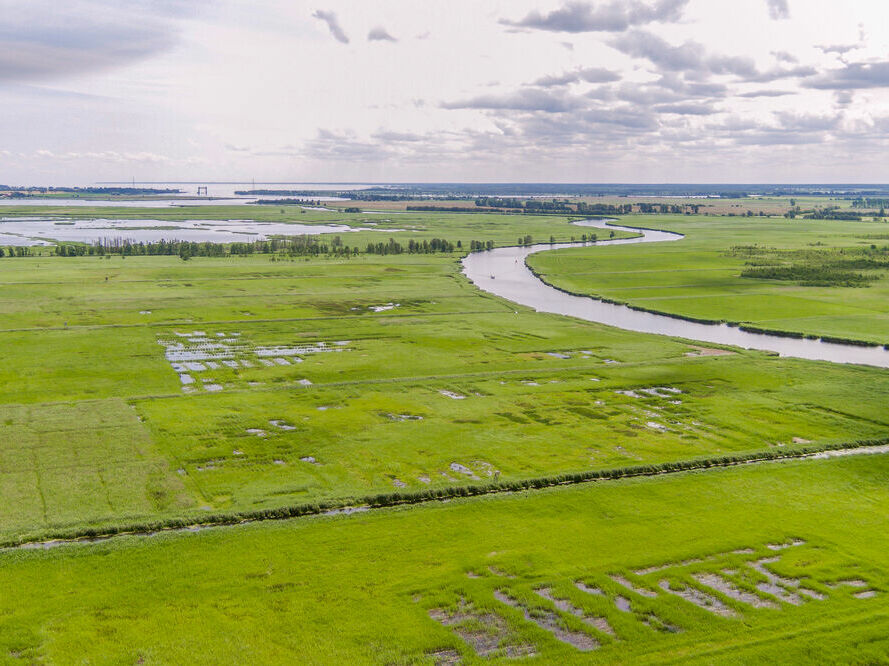Peatlands store twice as much carbon as the entire biomass of the World's forests. Huge areas have been drained for agricultural and land use and, thus turned into CO2 sources. Their rewetting is essential for reducing CO2 emissions. This connection has been clear for some years and substantiated by a large amount of data. However, little research has been done on what the rewetted peatlands actually look like, what kinds of vegetation develop and whether they functionally resemble their natural state. A central question focused on whether and how long it would take the rewetted areas to return to their natural states. The study now delivers the most comprehensive findings to date on fens in temperate latitudes.
The research team investigated restoration success by comparing 320 rewetted fen peatland sites to 243 near-natural peatland sites of similar origin across temperate Europe, between Wales in the West and Belarus in the East. A special "treasure" was the data from Mecklenburg-Vorpommern, where more than 30,000 ha of Germany’s total rewetted peatland area of approx. 70,000 ha can be found. The results suggest that rewetting drained fens encourages the establishment of tall, gramineous wetland plants such as reeds and bulrushes. In addition to the altered biodiversity, when compared with near-natural peatlands, rewetted peatlands show greater deviations in their water levels and more compacted peats. Surprisingly, the differences between rewetted and near-natural peatlands in terms of biodiversity (vegetation), ecosystem functions (characterised e.g. using geochemical and hydrological parameters) and land cover (spectral and temporal metrics) seem to remain for long periods. On the average, up to three decades after rewetting, peatlands showed no sign of returning to near-natural conditions. Instead, new types of ecosystems emerged in certain areas.
The UN Decade of Ecosystem Restoration that started in 2021 is the critical period for achieving our commitments of the Paris Agreement, also with regard to peat soils and peatland science. The Paris Agreement entails the rewetting of 500,000 km2 of drained peatlands throughout the world by 2050-2070. In Germany, that is about 50,000 ha per year, in Mecklenburg-Vorpommern about 8,500 ha per year. A better understanding of the resulting novel ecosystems is required to improve planning and implementation of peatland rewetting and subsequent management. Therefore, the authors of the article call for a concentrated consolidation of the research activities on rewetted peatlands in order to compile data in a joint and coordinated manner on the ecological functions of as wide a range of rewetted peatlands as possible, and to record new data where these are lacking.
Further Information:
Publication in Nature Communications
Post in Nature Portfolio Ecology and Evolution
Working group Experimental Plant Ecology, University of Greifswald
Greifswald Mire Centre
Working Group Landscape Ecology, University of Rostock
Contact at the University of Greifswald:
Prof. Dr. Jürgen Kreyling/Dr. Franziska Tanneberger
Institute of Botany and Landscape Ecology
Soldmannstr. 15
17487 Greifswald
Tel.: +49 3834 420 4131 or 4137
email: kreylinguni-greifswaldde, tanneuni-greifswaldde
Contact at the University of Rostock:
Dr. Gerald Jurasinski, Prof. Dr. Florian Jansen
Faculty of Agricultural and Environmental Sciences
Justus-von-Liebig-Weg 6
18059 Rostock
Tel. +49 381 498 3225
email: gerald.jurasinskiuni-rostockde, florian.jansenuni-rostockde
*Photo information
Large expanses of peatlands in the Lower Peene Valley have been rewetted since 1990. Some of this occurred by accident due to dam breaks e.g. the Baltic flood of 1995, some as part of planned rewetting projects like the large-scale conservation project “Peene Valley / Peene-Haff Peatland” (1992-2009), and as compensational measures for the construction of the A20 motorway. The photo shoes the mouth of the river Peene, with the Island of Usedom and the remains of the Karnin bridge in the background. The areas in the front of the photo were marginally drained and used for shallow peat extraction, but have now been rewetted and are hotspots for rare peatland plants. The flooded areas in the background belong to the former Immenstädt polder that, due to severe drainage, were subject to massive sagging and degradation, which led to the creation of expansive areas of shallow water once the wetlands had been drained.

